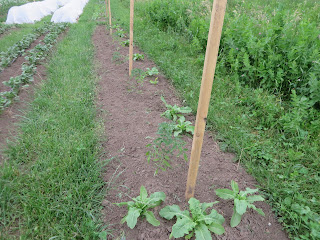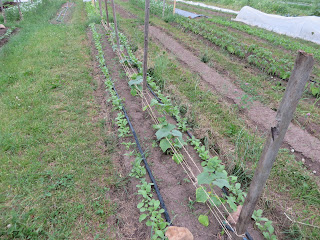I have included lettuce and frissee endive in this weeks delivery - details to be found on this weeks harvest page.
 |
| Blandings or Box turtle we helped across the road that day. |
Hello Everyone:
Eastern ontario is so full of little corners and details that I think we can spend a lifetime of week-ends exploring it.
While on a trip to view another farm property, we found across a farm gate store and went in to visit (hoping to get some inside info on the neighborhood).
We got that, and an impromptu tour of an alpaca farm.
 Could this be the place?
Could this be the place?Seems to cover a lot of our needs, but the soil appears a bit weak - too much sand, not enough silt and clay.
We'll need a more detailed look at the back pastures to see what the ground has in it.

Finally the peas have brought forth their bounty.
I set my plans last fall based on a worst case scenario of a "ground still frozen" date, and nature exceeded that by one week.
That delayed my pea planting by four days.
Our first harvest this week yielded enough for about half the customers; the rest of the pods required four days to mature.
Eight years of farming and still being reminded that I am not the one writing the rules.
The field is so full of food - I wish it were a ready now!
Here is one of two kale beds. I had hoped for three beds but brassica crops are tricky to place due to their negative impact on crops which follow them (beans and peas are less affected, and potatoes and squash seem to be not affected too much). There is more space in the autumn so I tend to plant more of them then.

Planting two kale beds makes it a bit trickier when trying to alternate with chard as the chard is easy to place in the field. Here is one of three chard beds.
As such, customers generally receive more chard than kale over the season.

The lettuce is finally starting to size up - the heavy rain of a week ago made a huge difference.
An hour of gentle, steady rainfall will provide the what a hi tech irrigation system requires a week to deliver to the crops.
(My irrigation system is definitely lo tech).
I try to do some of the lettuce watering by hand as I have found that the leaf quality improves immensely, especially in the heat.

Like it's close relation lettuce, the celtuce also prefers the hand watering.
Beds not serviced by the irrigation become natural choices for fitting this limited crop in - in this case, it is transplanted under a tomato bed.
Another example of under-sowing - radish under the cucumbers.
This is one of the ways that I can fit the brassica crops into the rotation without having too much impact on following crops.
Once the radish is out, the edges of the beds are cultivated and a light sowing of dutch clover is planted to replenish the soil.
When the cucumbers are finished, the entire bed is cleaned and then either cover cropped for the rest of the season, or perhaps reserved for extra fall potatoes if needed.
Look carefully, the first cucumber flowers are just starting.

I mentioned lo tech irrigation earlier. These irrigation tapes have the annoying ability to move on their own. Each time the system is turned off, the tapes warm up, expand, and twist about.
Part of the routine of turning the system on involves straitening each of them out.
Here's an example among the first carrot crop of the season.
The plastic mulch in the adjacent bed is suppressing weeds until I can get the bed cleaned up.
I don't care for the plastic mulch too much. There have been a few times when I have lifted it up to find dead frogs trapped underneath, particularly in the spring.
And inevitably, the mulch needs to be thrown out as it begins to break down. Neither the organic standard or my conscience will allow this to disintegrate into the soil.

Celeriac transplanted a couple of weeks ago.
I expect it won't look much different for another two weeks or so - I refer again to the posts back in early march when these pants were the size of a pencil tip.
This part of the field has a shallow water table so some of the heavy drinkers are planted here.
Spelt straw has hollow stems which make it a great insulator for overwintering crops or winter bedding for animals.
I am trying my hand at it as we hope to have year round pigs and ducks at our new farm.
As this si a small scale experiment, I am also including buckwheat within the spelt.
My theory is that buckwheat grows much quicker than the spelt, so I can scythe it's tops and allow that to fall back to the ground, providing nutrient for the soil and some additional weed suppression.
Unfortunately, I do not have a hammer mill to harvest the grain. Unlike other grains, spelt grain cannot be threshed by wacking it on the ground.
 The east field is finally planted - here are some of this years kidney beans.
The east field is finally planted - here are some of this years kidney beans.ate season potatoes and mini winter squash are soon to be planted in this plot as well.
Two years ago, our pigs were hard at work here eating a lot of the persistent weeds such as quack grass, dandelion, and wild parsnip.

The romano beans should be flowering soon, with beans to appear about two weeks after that...
So much promise, so much waiting, and so much to do in the meantime...



